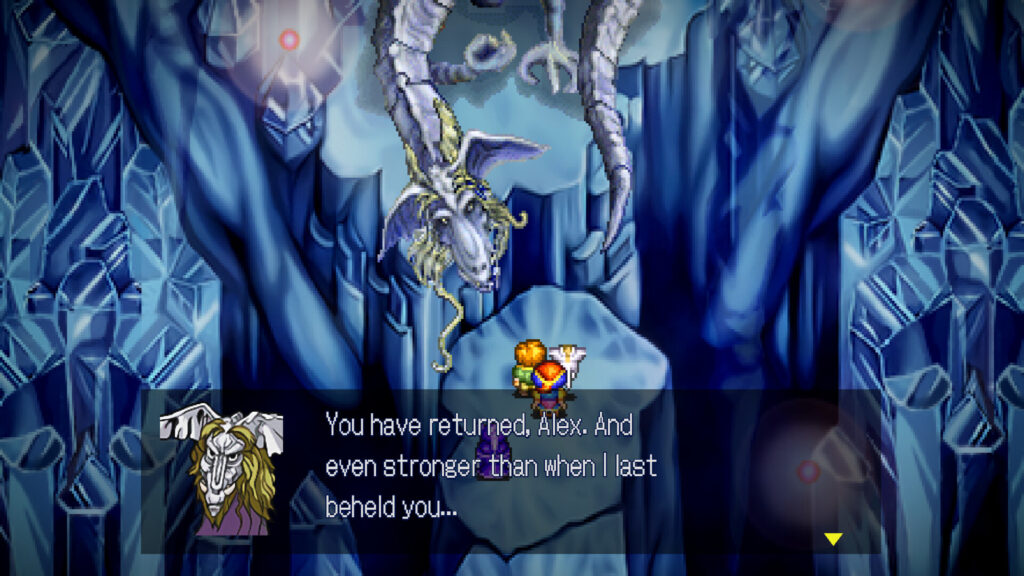Available on: PC, PlayStation, Switch, Xbox
Played on: Switch
Many older JRPG fans have fond nostalgia of the original Lunar: The Silver Star, thanks to its multiple remasters and re-releases throughout the years. I actually had the opposite issue — I still own my original copy of Lunar: Eternal Blue, the sequel, on Sega CD circa 1995. But I had never gotten around to playing the original, until now.
The Lunar Remastered Collection updates both 90s RPGs with widescreen support, enhanced character sprites, and new English voice acting. I’m proud to declare that one of my favorite RPGs as an impressionable young gamer still holds up with these welcome enhancements 30 years later.
Read on for our review of Lunar Remastered Collection!
A Song of Dragons
The Lunar series began in the early 90s, when the seminal genre was first introduced to Western audiences. The Remastered Collection builds upon the later updated versions from 1996 and 1998, making this Collection the most complete version of the games.
I spent the bulk of my time with the original Lunar. Both RPGs are quite similar in story structure: an earnest young man yearning to be a hero, his plucky flying cat-like companion, a supportive love interest who holds a powerful secret, and four guardian dragons. The stories aren’t terribly complex by today’s standards, and Silver Star Story’s initial motivation for adventure is shockingly tame, taking several towns, dungeons, and characters to really get the story rolling (in contrast, Eternal Blue’s story features a much more interesting start).
Once the full team is formed, I was quick to fall in love with the ex-lovers banter between Jessica and Kyle, and Nall, Alex’s loyal flying companion, with hilarious quips at nearly every interaction.
The RPG features an astounding amount of dialogue. Normally talking to NPCs gives repeated responses, but in Lunar, nearly everyone has at least two or three things to say (make sure to speak to the Blue Dragon in Silver Star Story over half a dozen times — great stuff!). This huge amount of writing creates a wonderful level of immersion, and I found myself stopping to smell the roses in each town far more than most JRPGs.
The art design looks great in widescreen, and the character sprites are clear without losing their personalities. There are no tedious random encounters at all in the overworld, which is refreshing. Dungeon crawls, whether they’re forests or caves or canyons, are paced perfectly, with visible enemies that can sometimes be avoided.
The one concession is that players can’t simply toggle between the original Classic versions (which are actually the remasters from the late 90s), or the new Remastered versions. To switch, players have to exit out to the main Remastered Collection menu, and make their selection.
Holding Out For a Hiro
Combat in the Lunar games is better than ever thanks to the most critical enhancement of all — speed up.
The original combat animations are agonizingly, achingly slow. Did we really put up with this back in the day? Speeding up animations is as simple as tapping the shoulder button, and increasing to 2x or 3x speed. Two times speed was perfect most of the time; only during the more tedious repeat combat encounters did I feel the need to bump it to max.
The auto-battle is also a nice option, and can be configured for each individual party member. But it’s a feature I rarely used; I honestly enjoy controlling my party, even if it’s just to hammer on the Attack command.
The early hours feature a lack of party members and abilities across both games, but that’s rectified relatively quickly.
![]() Unlike many turn-based RPGs of the era, Lunar uses a simple but meaningful positioning system. It’s not exactly tactical or grid-based, but heroes and enemies have to move to engage each other in melee. Players can set party member positions before battles, protecting long-range spellcasters behind the bulkier fighters.
Unlike many turn-based RPGs of the era, Lunar uses a simple but meaningful positioning system. It’s not exactly tactical or grid-based, but heroes and enemies have to move to engage each other in melee. Players can set party member positions before battles, protecting long-range spellcasters behind the bulkier fighters.
Plus, many area of effect spells target in a group, making it important to hit enemies while they’re close together. These elements add just the right amount of tactical layering on an otherwise straightforward battle of melee attacks, interspersed with magic abilities.
The one modern improvement the RPGs still lack is an autosave feature, which I found out the hard way during a particularly challenging early boss fight in the sewers. The ability to restart a boss fight would also have been nice, but the solution, as it was 30 years ago, is to save often, and frequently!
 The Rating
The Rating
The Lunar Remastered Collection is rated T for Teen, with Fantasy Violence, Mild Blood, Mild Language, Partial Nudity, Suggestive Themes, and Use of Alcohol. Despite its cartoonish pixel graphics, Lunar features a bit of blood and nudity (non-sexual) during anime cutscenes. Some dialogue makes innuendos, and alcohol use and references are pretty high, including party members who are teased for their drinking habits.
The Takeaway
When it comes to classic anime-inspired JRPGs, it doesn’t get much more classic than the Lunar series. The huge amount of writing, beautiful cutscenes, newly arranged music, classic hero’s journey, and fun characters make the Lunar Remastered Collection an easy recommendations for nostalgic fans and newcomers.
Let us know what you think of our Lunar Remastered Collection review on social media, and sign up for our weekly newsletter!


